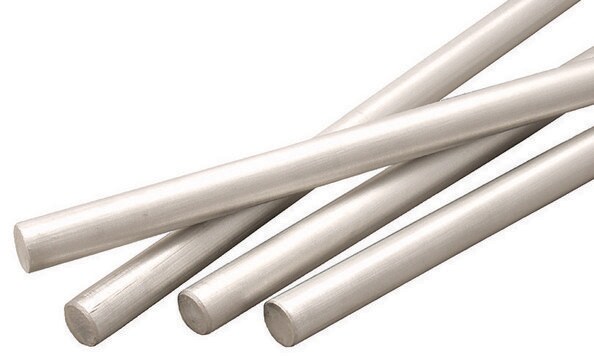GF72119729
Zinc
foil, 1m coil, thickness 0.1mm, as rolled, 99.95+%
Synonym(s):
Zinc, ZN000250
Sign Into View Organizational & Contract Pricing
All Photos(2)
About This Item
Empirical Formula (Hill Notation):
Zn
CAS Number:
Molecular Weight:
65.39
MDL number:
UNSPSC Code:
12141750
PubChem Substance ID:
NACRES:
NA.23
Recommended Products
vapor pressure
1 mmHg ( 487 °C)
Assay
99.95%
form
foil
manufacturer/tradename
Goodfellow 721-197-29
resistivity
5.8 μΩ-cm, 20°C
diam. × thickness
1 m × 0.1 mm
bp
907 °C (lit.)
mp
420 °C (lit.)
density
7.133 g/mL at 25 °C (lit.)
SMILES string
[Zn]
InChI
1S/Zn
InChI key
HCHKCACWOHOZIP-UHFFFAOYSA-N
Related Categories
General description
For updated SDS information please visit www.goodfellow.com.
Legal Information
Product of Goodfellow
Choose from one of the most recent versions:
Certificates of Analysis (COA)
Lot/Batch Number
It looks like we've run into a problem, but you can still download Certificates of Analysis from our Documents section.
If you need assistance, please contact Customer Support.
Already Own This Product?
Find documentation for the products that you have recently purchased in the Document Library.
Pritesh Hiralal et al.
ACS nano, 4(5), 2730-2734 (2010-04-27)
Solid-state and flexible zinc carbon (or Leclanche) batteries are fabricated using a combination of functional nanostructured materials for optimum performance. Flexible carbon nanofiber mats obtained by electrospinning are used as a current collector and cathode support for the batteries. The
Huibo Chen et al.
Nanoscale research letters, 5(3), 570-575 (2009-01-01)
We reported the optical and wettability properties of aligned zinc oxide micro/nanotube arrays, which were synthesized on zinc foil via a simple hydrothermal method. As-synthesized ZnO micro/nanotubes have uniform growth directions along the [0001] orientations with diameters in the range
Hongqin Liu et al.
ACS applied materials & interfaces, 1(9), 2086-2091 (2010-04-02)
Zinc, silicon, and steel superhydrophobic surfaces were prepared by a simple solution-immersion technique. In the case of zinc, the method consists of dipping of the substrate in a prehydrolyzed methanol solution of 1H,1H,2H,2H-(perfluorooctyl)trichlorosilane [CF(3)(CF(2))(5)(CH(2))(2)SiCl(3), PFTS] for 24 h at 50
Yang Liu et al.
Chemistry (Weinheim an der Bergstrasse, Germany), 13(23), 6667-6673 (2007-05-31)
Well-aligned zinc oxide microrod and microtube arrays with high aspect ratios were fabricated on zinc foil by a simple solution-phase approach in an aqueous solution of ethylenediamine (en). The shape of the ZnO microstructures can be easily modulated from rods
Zhengquan Li et al.
Chemistry (Weinheim an der Bergstrasse, Germany), 10(22), 5823-5828 (2004-10-09)
A solution surface-erosion route was successfully employed to produce one-dimensional (1D) ZnO nanostructures. ZnO nanorod arrays and three-dimensional urchin-like assemblies could be selectively obtained with different manipulations. In this process, zinc foil was introduced to an organic solution system and
Our team of scientists has experience in all areas of research including Life Science, Material Science, Chemical Synthesis, Chromatography, Analytical and many others.
Contact Technical Service





